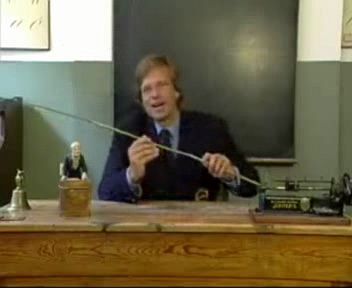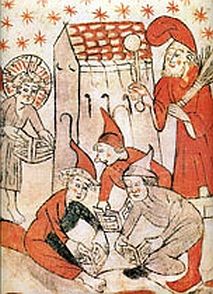Historically, the countries of Northern Europe, essentially Germanic in general cultural terms, had a strong tradition of corporal punishment. Denmark, despite its modern ultra-liberal image, was no exception. The ancient (presumably mediaeval) illustration above shows a schoolmaster holding a birch over his left shoulder.
Since 1814 the instrument to be used was a cane, which was not outlawed from schools until 1967. However, in the capital, Copenhagen, CP was abolished in 1952 in government schools.
The following notes by Keld Grinder-Hansen, Director of the Danish School Museum , were published in Frie Grundskoler No 11, 2004 (English translation below):
, were published in Frie Grundskoler No 11, 2004 (English translation below):
I gamle dage slog lærerne eleverne. Det er en viden som hver eneste skolebarn har i dag, og deres forældre og bedsteforældre bærer med glæde ved til bålet med historier om mere eller mindre raffinerede straffemetoder. Lussingerne sad løse, og ofte kunne eleverne selv vælge om de ville have en lussing nu eller en eftersidning på et senere tidspunkt. De fleste valgte den kontante afregning her og nu, for når de skulle forevise eftersidningssedlen hjemme, ville de højst sandsynlig blot få lussingen her og dermed dobbelt straf!
Det mest interessante ved disse historier er at lærerne faktisk siden 1814-skoleloven ikke har haf ret til at stikke eleverne lussinger. I 1814-loven blev straffemidlerne præciseret til at være den mundtlige påtale, eftersidningen og i alvorlige tilfælde slag med spanskrør. Lussingen blev benyttet og så længe samfundet accepterede fysiske afstraffelser af børn, fortsatte eleverne fra tid til anden med at få en "en huskekage" af læreren. Brugen af spanskrøret skulle følge nøje regler. Straffen blev udmålt i et bestemt antal slag der skulle påføres elevens bagdel. Efter executionen skulle straffen og begrundelsen herfor indføres i en særlig straffeprotokol. Sjovt nok har kun ganske få straffeprotokoller overlevet til i dag, ligesom der kun er bevaret få originale spanskrør. Spanskrøret blev afskaffet i det københavnske skolevæsen i 1952 medens det på landsplan forsvandt i 1967.

 English translation:
English translation:
In the old days teachers used to hit their pupils. Every schoolchild nowadays knows that, and their parents and grandparents are happy to come out with stories about more or less sophisticated methods of punishment. A slap round the face would be dished out freely, and pupils could often choose for themselves whether they would rather have a slap straight away or be given detention later on. Most of them opted to settle the bill on the spot, because if they had to show the detention slip when they got home, they would more than likely just get a clip round the ears there so they would be punished twice!
The most interesting thing about these stories is that since the Schools Act of 1814 teachers have not actually been allowed to slap their pupils. The 1814 Act specified the methods of punishment as being a verbal reprimand, detention and, in serious cases, a caning. Slapping was practised, and as long as society acquiesced in the corporal punishment of children, pupils still got a 'box round the ears' from teachers from time to time. There were certain rules to be followed for a caning. The punishment was administered in a specific number of strokes and had to be applied to the pupil's bottom. After it had been carried out, the type of punishment and the reason for it had to be entered in a special punishment book. Curiously, very few punishment books have survived to the present day, just as there are only a few original canes left. The cane was abolished in Copenhagen schools in 1952, whereas it disappeared throughout the country in 1967.
 RELATED VIDEO CLIP
RELATED VIDEO CLIP
 Brief extracts from an educational TV programme on a visit to the School Museum, where the Director shows a school cane. It appears to be a rattan, very long but rather thin. He taps it against his hand, which is misleading because, according to the above text, the punishment had to be applied to the student's buttocks. His remarks (in Danish) are a version of the notes reproduced above.
Brief extracts from an educational TV programme on a visit to the School Museum, where the Director shows a school cane. It appears to be a rattan, very long but rather thin. He taps it against his hand, which is misleading because, according to the above text, the punishment had to be applied to the student's buttocks. His remarks (in Danish) are a version of the notes reproduced above.
HERE IS THE CLIP:
[VIDEO CLIP TEMPORARILY UNAVAILABLE]
IMPORTANT: Copyright in this video material rests with the original copyright holders. This brief excerpt is reproduced under the "fair use" doctrine  for private, non-profit, historical research and education purposes only. It must not be redistributed or republished in any commercial context.
for private, non-profit, historical research and education purposes only. It must not be redistributed or republished in any commercial context.
 External links for Denmark/School CP
External links for Denmark/School CP


